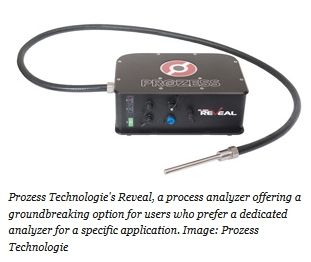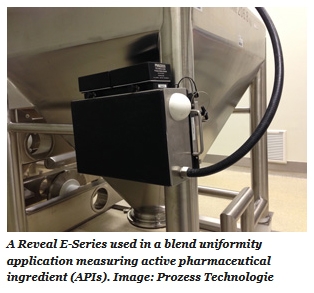Resources
Real-Time Process Measurement: A Sea Change in Manufacturing
Submitted by Chad Lieber | Prozess Technologie and Brian Sullivan | Valin

There’s an unlimited number of attributes that manufacturers are looking to measure on the plant floor—everything from color mixtures to chemical baths need to be constantly tested, analyzed and corrected. Without a process measurement system in place to give real-time feedback, this can be an impossible task. However, recent implementations based on the science of spectroscopy are revealing themselves ideal for manufacturers looking to benefit from real-time process measurement.
How does it work?
Spectroscopy is the study of the interaction between matter and radiated energy. While spectroscopy can be performed using any portion of the electromagnetic spectrum, from x-rays to radio waves, its use in process measurement typically involves the portion from the ultraviolet through the infrared that’s generically termed “light”. As it is applied to process measurement, spectroscopy typically means illuminating the sample stream with a known range of light and carefully analyzing the reflected or absorbed light to extract chemical information about the sample. Because different samples and molecules interact with light in unique ways, this approach makes it possible to not only detect the proverbial needle in a haystack, but also quantify the amount of the needle or even multiple needles with high accuracy. Perhaps, more importantly, all of this analysis can be performed in-situ, within the sample stream, in seconds or less.
There are four main wavelength regions of light typically used in spectroscopy-based process measurement: ultraviolet (UV), visible (VIS), near-infrared (NIR) and infrared (IR). UV spectroscopy is the measurement of the very short wavelengths outside the blue-violet color human eyes can perceive. This type of spectroscopy is best suited for the measurement of very low concentrations of a target molecule in a liquid stream. VIS spectroscopy is the measurement of light that a person’s eyes perceive as color, but with high sensitivity to accurately determine a wide range of product color attributes, brightness and clarity. NIR spectroscopy measures light just beyond the red color human eyes can perceive, where it interacts with the molecules to provide chemical detection and quantification at high speed. The molecular interactions that occur with NIR light are overtones of their fundamental interactions in the IR, so the fast measurement speed in the NIR does come at the expense of sensitivity, and NIR is typically used to quantify target species at percent-level concentrations. IR spectroscopy measures light even longer than the NIR, well beyond what can be seen and into the ranges that we feel as heat. This light directly probes molecular bonds and can be used to detect and quantify a wide range of target molecules to very low concentrations, even in gas phase.
While the target molecule and its environment define which spectroscopy best serves the application, obtaining the optical signal from the sample is only half of the solution. Converting that optical information into something useful, such as the concentration of a target compound in a process stream, entails a combination of signal processing and statistics that has become a science of its own, called chemometrics. Improvements in these chemometric methods, along with advances in the optical components comprising the process analyzers, can now deliver information about processes that was unavailable in the past, and certainly wasn’t available in such convenient forms. The technology provides chemical and physical information in-line that’s non-destructive, instant and requires no sample preparation. It also requires no additional chemicals, no hazardous waste products and no trained technicians to operate.
A Reveal E-Series used in a blend uniformity application measuring active pharmaceutical ingredient (APIs). Image: Prozess TechnologieA Reveal E-Series used in a blend uniformity application measuring active pharmaceutical ingredient (APIs). Image: Prozess Technologie

The biggest reason there’s more attention paid to spectroscopy lately is the revolutionary new way these process measurement devices are packaged. What once took a symphony of engineers and scientists to analyze the process and deduce results can now be done by nearly anyone working on the plant floor. Process measurement devices using spectroscopy can now be controlled via any Web-enabled device or, conventionally, within the automation control systems in the factory. Users are able to control the analyzer, stream real-time data, log operator activity and monitor output from anywhere they desire, whether inside the plant or across the globe.
Spectroscopic process measurement solutions are also gaining popularity because of their versatility. The applications are nearly limitless, and include such varied purposes as chemical quantification, cleaning validation, color measurement, reaction monitoring, ensuring blending uniformity and moisture determination. A number of interfaces are available to connect the analyzer to the process stream, including reflectance probes, dip probes and flow-through cells, that can either be directly connected to the process analyzer or connected remotely via fiber optics. Furthermore, liquids, solids, powders and gases all can be analyzed using spectroscopy. And, as opposed to chemical sensors and other analytical methods employed for in-line process measurement, optical spectroscopy allows the same system to measure a number of parameters simultaneously and be reprogrammed should there be changes to the process stream composition.
It’s easy to see why those in manufacturing environments are beginning to see these solutions as not only viable, but critical. User-ready spectroscopic process analyzers are no longer cost prohibitive nor labor intensive. Improved manufacturing efficiency and product quality afforded by real-time, in-line process analyzers are invaluable. As companies continue to explore ways to differentiate their operations from that of the competition, it’s more evident that implementing an efficient process measurement system is a critical piece of the puzzle.
Article featured in R&D Magazine.
A lesson for me is that I need to involve you earlier in the program.
You were tireless in your support and it will not be forgotten!
Latest from Valin's Blog
The NIST Chemistry WebBook contains a great deal of information regarding the properties of a broad range of chemicals and is helpful for those who deal with chemical processes.In this article, Jon Monsen has outlined the procedure for finding the actual density of a gas using the WebBook.
